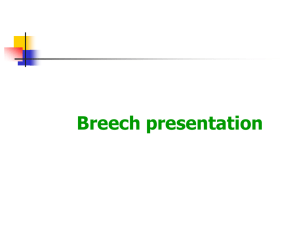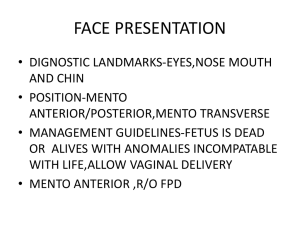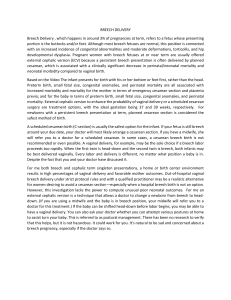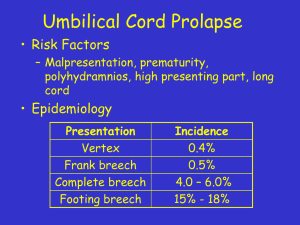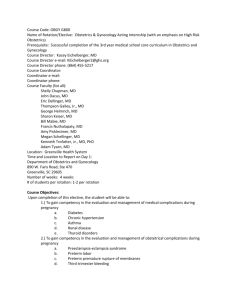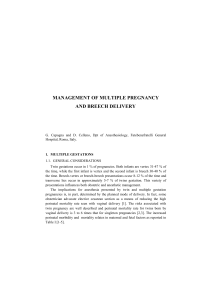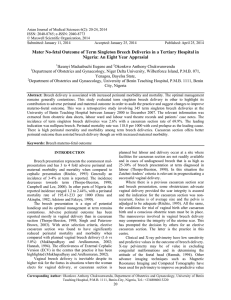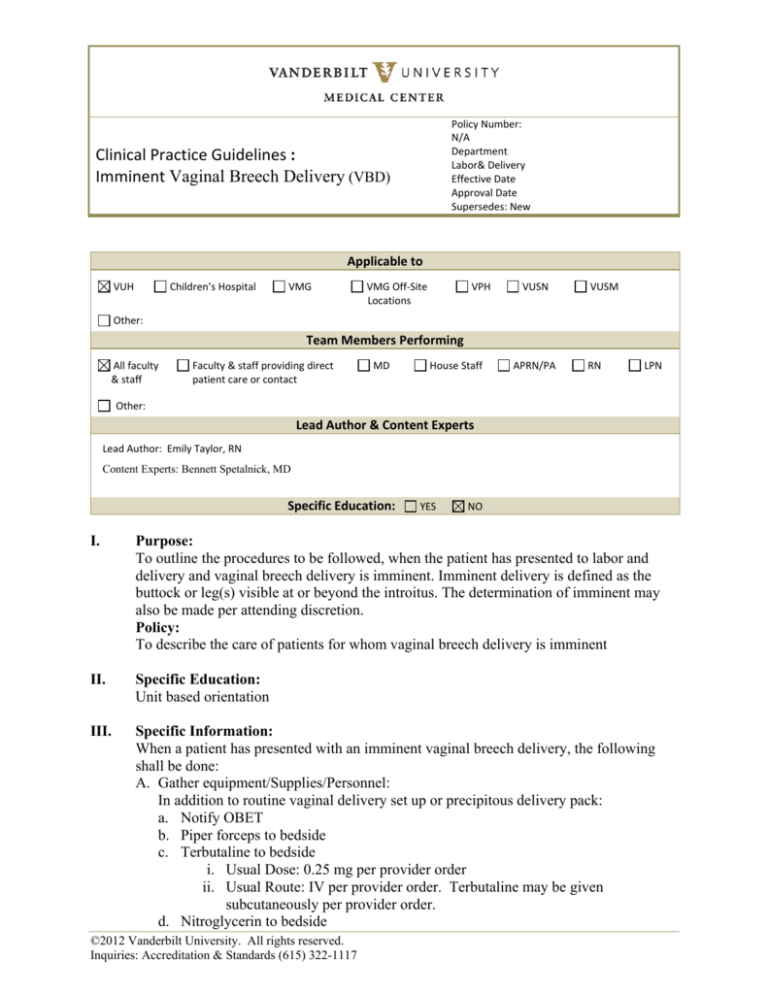
Policy Number: N/A Department Labor& Delivery Effective Date Approval Date Supersedes: New Clinical Practice Guidelines : Imminent Vaginal Breech Delivery (VBD) Applicable to VUH Children’s Hospital VMG VMG Off‐Site Locations VPH VUSN VUSM Other: Team Members Performing All faculty & staff Faculty & staff providing direct patient care or contact MD House Staff APRN/PA RN LPN Other: Lead Author & Content Experts Lead Author: Emily Taylor, RN Content Experts: Bennett Spetalnick, MD Specific Education: YES NO I.
Purpose:
To outline the procedures to be followed, when the patient has presented to labor and
delivery and vaginal breech delivery is imminent. Imminent delivery is defined as the
buttock or leg(s) visible at or beyond the introitus. The determination of imminent may
also be made per attending discretion.
Policy:
To describe the care of patients for whom vaginal breech delivery is imminent
II.
Specific Education:
Unit based orientation
III.
Specific Information:
When a patient has presented with an imminent vaginal breech delivery, the following
shall be done:
A. Gather equipment/Supplies/Personnel:
In addition to routine vaginal delivery set up or precipitous delivery pack:
a. Notify OBET
b. Piper forceps to bedside
c. Terbutaline to bedside
i. Usual Dose: 0.25 mg per provider order
ii. Usual Route: IV per provider order. Terbutaline may be given
subcutaneously per provider order.
d. Nitroglycerin to bedside
©2012 Vanderbilt University. All rights reserved.
Inquiries: Accreditation & Standards (615) 322-1117
Policy Number
N/A i. Usual Dose: 100 mcg per provider order
ii. Nitroglycerine may be given up to 200 mcg per provider order.
iii. Route: IV per provider order.
e. catheter to bedside
f. Lidocaine 1% to bedside for laceration repair as needed.
B.
IV.
V.
VBD procedure:
a. Informed consent obtained and documented for Cesarean Delivery
b. Notify anesthesia and NICU of imminent breech delivery if not already present
c. Obtain IV access (18 gauge or larger preferred)
d. Availability of performing immediate Cesarean Delivery. Patient to be moved to
the operating room for delivery with double set up per attending discretion
related to imminence of delivery.
e. Use of tocolytics per provider request i.e., Terbutaline and Nitroglycerin as
noted in III. A.
Clinical Implications:
A. Nursing care will be provided according to the unit guidelines.
B. VBD is a high risk delivery; documentation according to labor policy. Maneuvers utilized
will be confirmed with physician and documented with time of occurrence
C. During the delivery process and as directed by provider, a designated staff member will
apply pressure to favor flexion and engagement of the fetal head.
D. Delivery of the shoulders will be communicated by the provider
E.
After delivery of the shoulders, the timekeeper will continue to monitor the time and
fetal heart rate palpated through the umbilical cord , calling out both every 30
seconds to remind the provider and team.
F. All personnel will use closed loop communication
G. Cord Gas Value obtained per current protocol or physician order.
Patient/Family Education:
A. Plan of care
B. Unit routine
VI.
Documentation:
Will be done according to hospital and unit guidelines and occur in the
following places:
A. Consent for anesthesia and Cesarean Delivery will be documented in the OB
EMR if applicable
B. Documentation will be completed in the EMR according to hospital and unit
guidelines
VII.
References:
Policy Number
N/A A. Fetal Heart Rate Monitoring Policy
B. Nursing Management of the Labor Patient
Cheng, M., & Hannah, M. (1993). Breech delivery at term: a critical review of the
literature. Obstetrics & Gynecology, 82(4), 605-618.
Giuliani, A., Schöll, W. M., Basver, A., & Tamussino, K. F. (2002). Mode of delivery
and outcome of 699 term singleton breech deliveries at a single center. American journal
of obstetrics and gynecology, 187(6), 1694-1698.
Goldenberg, R. L., & Nelson, K. G. (1984). The unanticipated breech presentation in
labor. Clinical Obstetrics and Gynecology, 27(1), 95-105.
Hofmeyr, G., Lockwood,C., Barass, V. (2012) Delivery of the fetus in breech
presentation. http://www.uptodate.com/contents/delivery-of-the-fetus-in-breechpresentation?detectedLanguage=en&source=search_result&search=breech+delivery&sel
ectedTitle=1%7E150&provider=noProvider
Kotaska, A., Menticoglou, S., Gagnon, R., Farine, D., Basso, M., Bos, H., ... &
Roggensack, A. (2009). Vaginal delivery of breech presentation: No. 226, June 2009.
International Journal of Gynecology & Obstetrics, 107(2), 169-176.
OBSTETRICS, S. (2002). Mode of term singleton breech delivery. International Journal
of Gynecology & Obstetrics, 77, 65-66.
VIII. Contributors:
Emily Taylor, RN, MSN, EFM-C
Barry Grimm, MD
IX.
Endorsement:
Obstetric Patient Care Center Committee
OB/GYN Executive Committee
X.
Approval:
Howard W. Jones III, MD
Professor and Chairman Department of Obstetrics and Gynecology
Date
Bennett Spetalnick, MD.
Director Obstetric Patient Care Center (OB-PCC)
Date
Tejuana Holmes, MSN, RN
Administrative Director of Women’s Patient Care Center
Date


